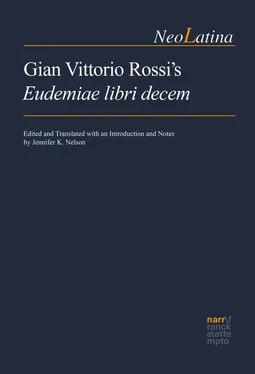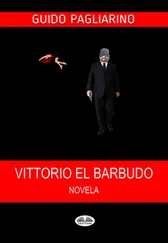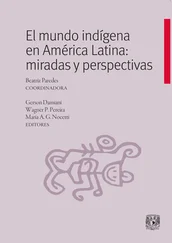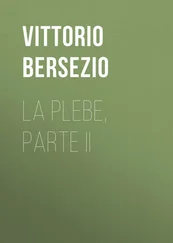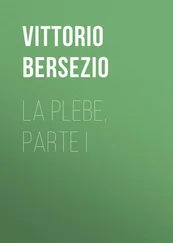1 ...6 7 8 10 11 12 ...44 perform the function played in the real world by certain persons, but they are not portraits of the persons themselves. Meleander, the king of Sicily … is not a portrait of Henry IIIHenry III, King of France, but a character who labors under the same kinds of difficulties as those of Henry III.15
By contrast, a large number of the pseudonymous characters in Eudemia map onto specific historical people, most of whom were in his own circle of acquaintance—and more than half of whom are profiled in his Pinacotheca .
Because RossiRossi, Gian Vittorio’s mocking and inconclusive Eudemia resembles BarclayBarclay, John’s Euphormionis lusinini satyricon much more than it does his Argenis Argenis, it is telling that Rossi does not specifically mention the Euphormionis lusinini satyricon as his model, especially since we know that he read it. Rossi’s biography of John Barclay, included in the third book of his Pinacotheca , provides a clue as to why this might be the case:
John BarclayBarclay, John is among those non-Roman and even non-Italian [rhetoricians] who have devoted themselves to the study of Latin letters. I have read his Argenis Argenis, and I have also had a taste of part of his Euphormio Euphormio, before it was against the law for bookstores to sell it or for people to have it at home and read it.16
RossiRossi, Gian Vittorio’s mention of the limited access booksellers and consumers had to the Euphormionis lusinini satyricon refers to the fact that Part Two of the work was placed on the Index of Prohibited Books almost immediately after its publication in 1607.17 This is because John BarclayBarclay, John, a Roman Catholic but a “partisan of British interests,” wrote critically of the Jesuits and of the Pope.18 Comparing his work to Argenis Argenis, instead of to his more likely model Euphormionis lusinini satyricon , benefited Rossi in two ways: he could distance himself from a controversial title; at the same time, by associating his work with an enormously popular and successful novel that, by the time of Eudemia ’s 1637 publication date, existed in at least thirteen Latin editions and twelve translations,19 he could make Eudemia more attractive to potential publishers, booksellers, and readers. Similar to his soft Horatian turn discussed above, Rossi’s association of Eudemia with Barclay’s romance, as opposed to his harsh (and officially condemned) Euphormis lusinini satyricon , was a way to remove some of the bite from his satire.
Translating Gian Vittorio RossiRossi, Gian Vittorio’s Latin
Gian Vittorio RossiRossi, Gian Vittorio is a very approachable author. He was educated in the Jesuit tradition based on a Classical curriculum, which provided him a solid foundation in the liberal arts. After completing his schooling, but finding it difficult to establish himself in a professional career, Rossi recommitted himself to humanistic study. He found his niche in the Accademia degli Umoristi, the intellectual and artistic community associated with the court of Urban VIIIUrban VIII, Pope. To support his private studies, Rossi built up his own library of Classical authors, as is evident in a 1604 letter to the Flemish printer Jan MoretusMoretus, Jan, in which he asked the latter to locate as many works as possible “that relate to the humanities, as they are called,” and to send them to him.1 Authors such as CiceroCicero, Marcus Tullius, PlautusPlautus, Titus Maccius, QuintilianQuintilian, LivyLivy, SallustSallust, VirgilVirgil, HoraceHorace, OvidOvid, and TerenceTerence were the inspiration and models for Rossi’s prose and poetry.2
RossiRossi, Gian Vittorio mastered these studies and was recognized by his contemporaries as a superior Latinist, even surpassing certain renowned fourteenth- and fifteenth-century Italian humanists in the eyes of his friends. Gabriel Naudé, for example, wrote of Rossi’s Latin:
Everything you write, whether in prose or verse, so grabs and delights me that, compared to you, my former favorites BemboBembo, Pietro and PolizianoPoliziano, Angelo now seem plain and unaccomplished. Everything you say inspires my own sweet style. Pytho Pythoherself resides on your lips to such an extent that, in all of the ways you emulate the ancients in every other virtue, you too are second to none of them in speaking and writing.3
In a dedication to Leone AllacciAllacci, Leone’s work De templis Graecorum recentioribus ad Ioannem Morinum , Barthold NihusNihus, Barthold (Joan BlaeuBlaeu, Joan’s editor) addresses RossiRossi, Gian Vittorio as “Perillustri domino Iano Nicio Erythraeo, aevi nostri Varroni ac Tullio” (“To the most illustrious Ianus Nicius Erythraeus, the VarroVarro, Publius Terentius and [CiceroCicero, Marcus Tullius] of our time”).4
RossiRossi, Gian Vittorio’s Latin continued to enjoy this level of acclaim even after his death. In his Elogii d’huomini letterati , Lorenzo CrassoCrasso, Lorenzo (b. 1623) dedicated a profile to the “Gentilhuomo Romano chiamato Gio: Vittorio de’ Rossi” noting that Rossi acquired through his studies “the purity of the Latin language.”5 The renowned German jurist and philosopher Johann Christian Gottlieb HeinecciusHeineccius, Johann Christian Gottlieb (1681–1741) singled Rossi out as one of the few humanists to have achieved Ciceronian eloquence, particularly in the epistolary genre.6 Prospero MandosioMandosio, Prospero (1643–1724) had similarly fulsome praise for Rossi’s Latin in his work on Roman authors titled Bibliotheca Romana, seu, Romanorum scriptorum centuriae :
[RossiRossi, Gian Vittorio] had a most elegant, sweet, and pleasant way of speaking that was commended by every manner of praise from all quarters; they say that he earned this glory because he spoke Latin purely, pristinely, ornately, elegantly, and in a truly Latin manner, so much so that the wisest and most learned men said that whoever needed to learn to write Latin should learn that skill from Ianus Nicius Erythraeus.7
Along with these explicit statements of appreciation for RossiRossi, Gian Vittorio’s prose, admiration for his Latin is evident in instances of unacknowledged imitation, especially in Germany. The German jurist, poet, and composer Kaspar ZieglerZiegler, Kaspar, for example, quotes almost word for word from Rossi’s description of a dishonest soldier of a religious military order in the beginning of Eudemia Book Eight for a section of his discourse on the subject of unscrupulous lawyers ( rabulae ) titled Rabulistica, sive, De artibus rabulariis dissertatio. 8 Similarly, the German Calvinist theologian and historian Daniel GerdesGerdes, Daniel quotes almost directly from Rossi’s description of a carpenter named BaldocciusBaldoccius in Book Six to describe a Minorite (a Franciscan friar of the Order of Friars Minor) named Franciscus in his Historia reformationis, sive, Annales evangelii saeculo XVI .9
Even into the nineteenth century, some compendia of Latin texts included passages from RossiRossi, Gian Vittorio’s work as exemplary specimens of Latin prose. For example, a French publication from 1818, titled Leçons latines modernes de littérature et de morale , showcases as models two passages from Eudemia and one passage from Pinacotheca imaginum illustrium ; these same passages are found in a similar German publication from 1825.10
Despite his mastery of Ciceronian eloquence, RossiRossi, Gian Vittorio became more and more drawn, as GerboniGerboni, Luigi explains, to the “conversar familiare” (conversational style) of the Roman playwrights PlautusPlautus, Titus Maccius and TerenceTerence, because he appreciated their humor, levity, and their ability to observe and represent everyday life and customs.11 To quote Rossi’s own words:
Читать дальше
